
18th Edition
IET Wiring Regulations
Wiring Systems and Fault Finding for Installation Electricians
This book deals with an area of practice that many students and non-electricians find particularly challenging. It explains how to interpret circuit diagrams and wiring systems, and outlines the principles of testing before explaining how to apply this knowledge to fault finding in electrical circuits.
A handy pocket guide for anybody who needs to be able to trace faults in circuits, whether in domestic, commercial or industrial settings, this book will be extremely useful to electricians, plumbers, heating engineers and intruder alarm installers.
Fully up to date with the 18th Edition IET Wiring Regulations 2018.
Covers all the principles and practice of testing and fault diagnosis in a way that is clear for students and non-electricians.
Expert advice from an engineering training consultant, supported with colour diagrams and key data.
Brian Scaddan, I Eng, MIET, is an Honorary Member of City & Guilds and has over 45 years experience in further education and training. He was Director of Brian Scaddan Associates Ltd, an approved training centre offering courses on all aspects of electrical installation contracting, including those for City & Guilds and EAL. He is also a leading author of books on other installation topics.
By the same author
18th Edition IET Wiring Regulations: Design and Verification of Electrical Installations, 9th ed, 978-1-138-60600-5
18th Edition IET Wiring Regulations: Explained and Illustrated, 11th ed, 978-1-138-60605-0
18th Edition IET Wiring Regulations: Electric Wiring for Domestic Installers, 16th ed, 978-1-138-60602-9
18th Edition IET Wiring Regulations: Inspection, Testing and Certification, 9th ed, 978-1-138-60607-4
Electrical Installation Work, 8th ed, 978-1-138-84927-3
PAT: Portable Appliance Testing, 4th ed, 978-1-138-84929-7
The Dictionary of Electrical Installation Work, 978-0-08-096937-4
18th Edition
IET Wiring Regulations
Wiring Systems and Fault Finding for Installation Electricians
7th Edition
Brian Scaddan

Seventh edition published 2019
by Routledge
2 Park Square, Milton Park, Abingdon, Oxon, OX14 4RN
and by Routledge
52 Vanderbilt Avenue, New York, NY 10017
Routledge is an imprint of the Taylor & Francis Group, an informa business
2019 Brian Scaddan
The right of Brian Scaddan to be identified as author of this work has been asserted by him in accordance with sections 77 and 78 of the Copyright, Designs and Patents Act 1988.
All rights reserved. No part of this book may be reprinted or reproduced or utilised in any form or by any electronic, mechanical, or other means, now known or hereafter invented, including photocopying and recording, or in any information storage or retrieval system, without permission in writing from the publishers.
Trademark notice: Product or corporate names may be trademarks or registered trademarks, and are used only for identification and explanation without intent to infringe.
First edition published 1991 by Newnes, an imprint of Elsevier
Sixth edition published by Routledge 2015
British Library Cataloguing-in-Publication Data
A catalogue record for this book is available from the British Library
Library of Congress Cataloging-in-Publication Data
A catalog record has been requested for this book
ISBN: 978-1-138-60611-1 (hbk)
ISBN: 978-1-138-60609-8 (pbk)
ISBN: 978-0-429-46687-8 (ebk)
Typeset in Kuenstler 480 and Trade Gothic by
Servis Filmsetting Ltd, Stockport, Cheshire
Contents
The aim of this book is to help the reader to approach the drawing and interpretation of electrical diagrams with confidence, to understand the principles of testing and to apply this knowledge to fault finding in electrical circuits.
The abundant colour diagrams with associated comments and explanations lead from the basic symbols and simple circuit and wiring diagrams, through more complex circuitry, to specific types of wiring systems and, finally, to the methodical approach to fault finding.
The new edition has been brought fully in line with the 18th Edition IET Wiring Regulations.
Brian Scaddan
Important terms/topics covered in this chapter:
BS EN 60617 symbols
Diagrams
Circuit convention
Relay logic
By the end of this chapter the reader should:
be aware of the correct symbols to be used on diagrams,
know the different types of diagrams in general use and why they are used,
understand circuit convention and its importance in interpreting diagrams,
understand simple relay logic and its application to PLCs.
This is an area often overlooked or even ignored. The IET Wiring Regulations require that diagrams, charts, tables or equivalent forms of information are made available to the installer and inspector and tester.
BS EN 60617 gives the graphical symbols that should be used in all electrical/electronic diagrams or drawings. Since the symbols fall in line with the International Electrotechnical Commission (IEC) document 617, it should be possible to interpret non-UK diagrams. Samples of the symbols used in this book are shown in .
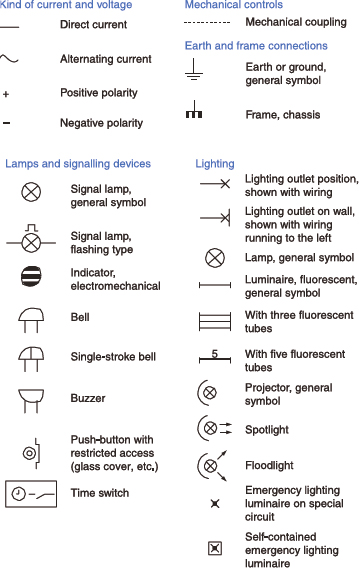
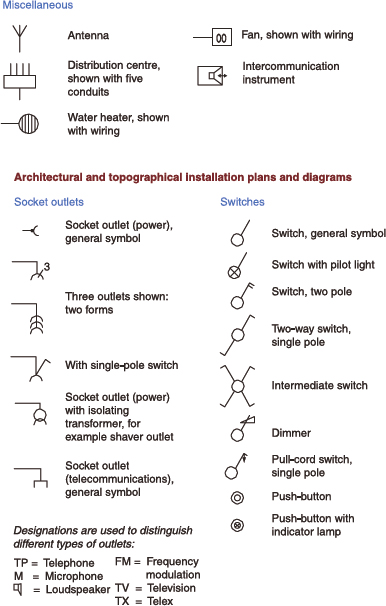
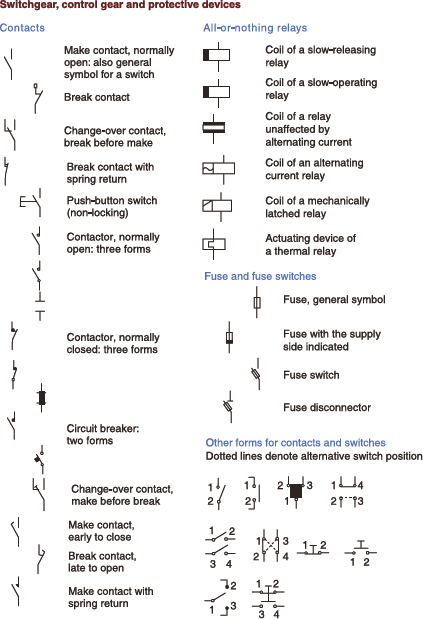
FIGURE 1.1 BS EN 60617 symbols.
The four most commonly used diagrams are the block diagram, interconnection diagram, the circuit or schematic diagram and the wiring or connection diagram.
Block diagrams
These diagrams indicate, by means of block symbols with suitable notes, the general way in which a system functions. They do not show detailed connections ().
Interconnection diagrams
In this case, items of equipment may be shown in block form but with details of how the items are connected together ().
Circuit or schematic diagrams
These diagrams show how a system works, and need to pay no attention to the actual geographical layout of components or parts of components in that system. For example, a pair of contacts which form part of, say, a timer may appear in a different and quite remote part of the diagram than the timer operating coil that actuates them. In this case some form of cross-reference scheme is needed (e.g. T for the timer coil and T1, T2, T3, etc. for the associated contacts).

FIGURE 1.2 (a) Security system, (b) Intake arrangement for domestic installation.
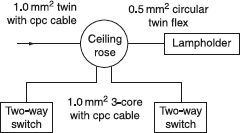

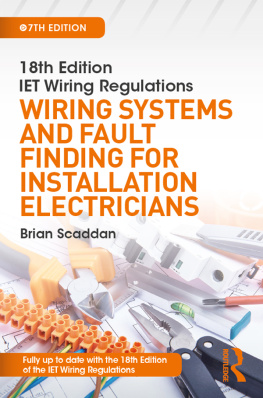
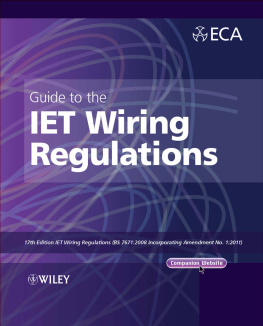

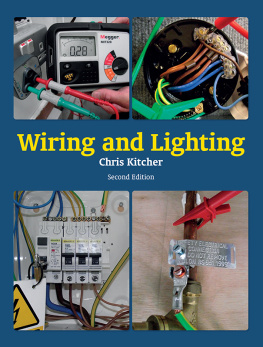
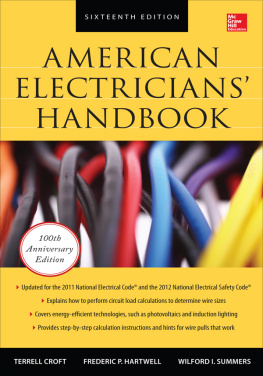
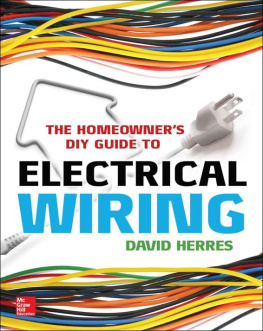
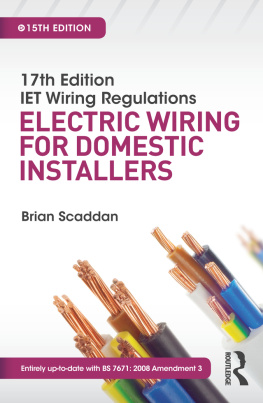
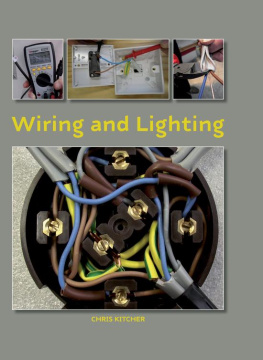
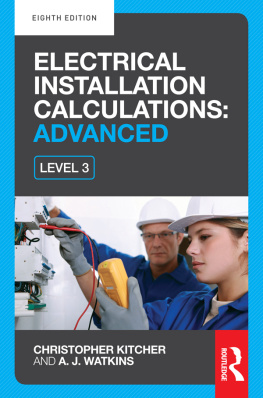





 FIGURE 1.2 (a) Security system, (b) Intake arrangement for domestic installation.
FIGURE 1.2 (a) Security system, (b) Intake arrangement for domestic installation.